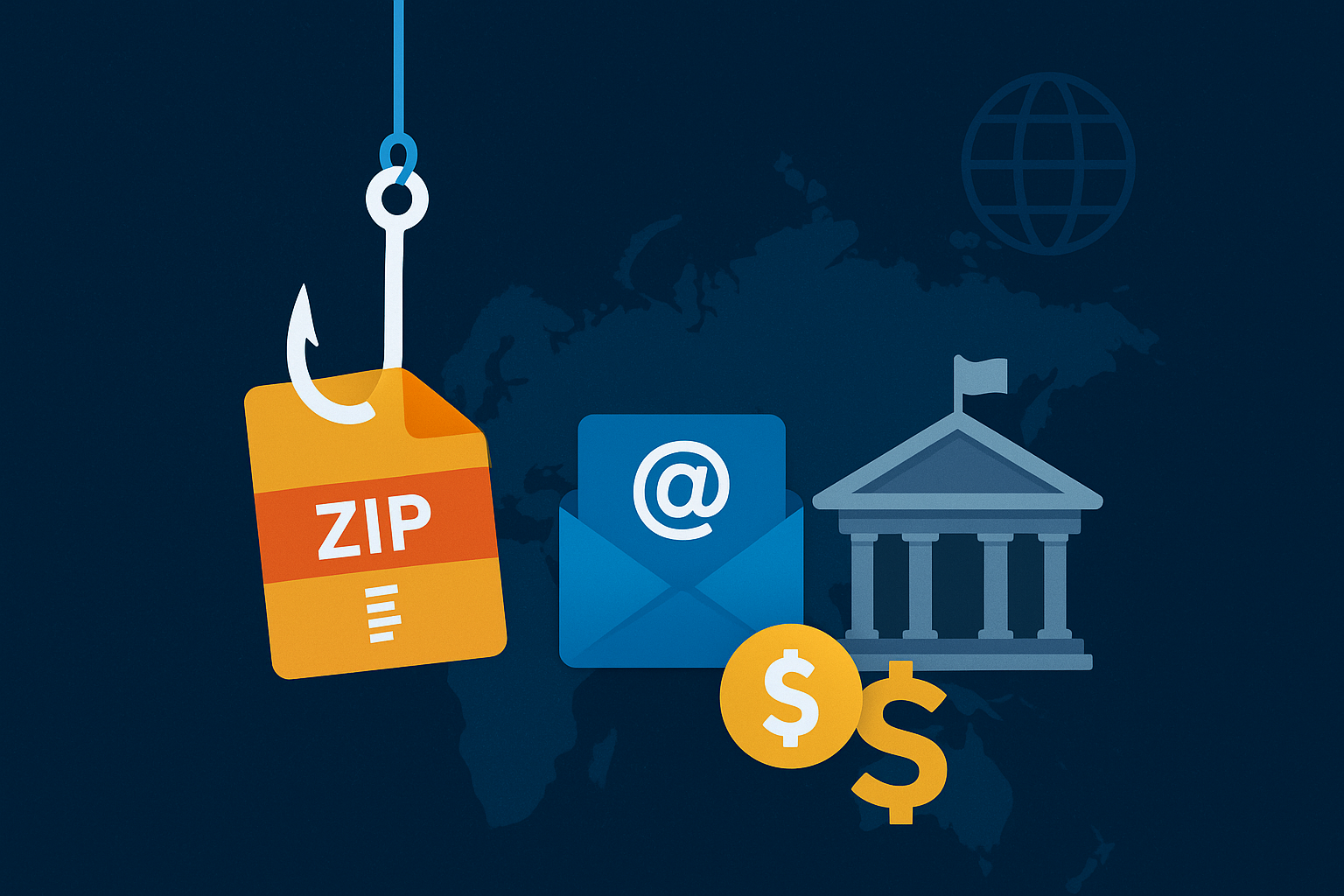A new wave of phishing attacks is sweeping across East and Southeast Asia, targeting government and financial organizations through multilingual ZIP file lures and shared phishing templates, according to Hunt.io’s latest analysis.
This campaign marks a significant evolution in phishing strategy – one that blends automation, regional customization, and infrastructure reuse to reach multiple countries simultaneously. The investigation, powered by Hunt.io’s AttackCapture™ and HuntSQL™ datasets, uncovered dozens of interconnected phishing domains operating in Chinese, Japanese, and English, each customized to local audiences while sharing the same backend logic and file delivery structure.
Inside the Campaign: From Taiwan to Japan and Beyond
Researchers traced 28 phishing webpages grouped into three main clusters:
- 12 Chinese,
- 12 English, and
- 4 Japanese websites.
All shared the same design, file naming patterns, and malicious download mechanisms, using deceptive ZIP or RAR files disguised as official documents.
The malicious archives carried filenames such as:
- “Tax Invoice List” (
稅務電子發票名單.rar), - “Import-Export Declaration” (
進出口申報.zip), and - “Notice of Salary System Revision” (
給与制度改定のお知らせ.zip).
These lures were tailored to local languages and bureaucratic processes — such as payroll, taxation, and compliance — making them highly convincing to regional targets.
The campaign’s infrastructure, hosted primarily on Kaopu Cloud HK Limited servers, connects multiple phishing domains located in Japan, Singapore, Hong Kong, and Cambodia, revealing how adversaries recycle and automate phishing deployment across borders.
Automated and Scalable: The New Phishing Toolkit
One of the most striking discoveries is the shared backend scripts (download.php and visitor_log.php), used to automatically log visitors and deliver malicious ZIP files only when conditions are met.
This logic — observed across all language clusters — suggests that attackers have moved beyond manual phishing operations toward automated, modular phishing frameworks capable of producing multilingual campaigns at scale.
“The uniformity of the scripts and templates shows a centralized toolkit being reused across countries,” analysts noted. “It’s not just one campaign — it’s an infrastructure-as-a-service model for phishing.”
The Bigger Picture: Regional Risk Expands
While this campaign is concentrated in East and Southeast Asia, it highlights a growing trend with global implications.
Phishing operators are increasingly localizing attacks linguistically and culturally, making them more effective — and harder to detect — than traditional one-language campaigns.
In regions like the Middle East and Africa (MEA), where multilingual business environments and digital transformation are accelerating, similar tactics could soon emerge.
Organizations across the GCC, North Africa, and Sub-Saharan Africa — particularly in finance, government, and critical services — should closely monitor these developments to stay ahead of emerging global phishing tactics.
Why It Matters
The shift toward automation-driven phishing infrastructure means that adversaries can now:
- launch attacks faster,
- adapt language and tone per region, and
- reuse the same code and hosting environment across multiple countries.
This not only reduces their operational cost but also increases the sophistication and reach of phishing campaigns, threatening both local and international entities.
10 Recommended Actions for Security Teams
To protect against this type of multilingual, ZIP-based phishing attack, cybersecurity teams should implement the following measures:
- Block and monitor suspicious domains — especially those using extensions like
.vip,.xin,.sbs,.site, or.top. - Inspect traffic to
download.phporvisitor_log.phpendpoints, which are common in these attacks. - Harden mail gateways to flag or quarantine ZIP/RAR attachments with tax or HR-themed filenames.
- Use advanced sandboxing to detonate and analyze compressed attachments before delivery.
- Educate employees about multilingual phishing attempts — awareness is key (training.saintynet.com).
- Limit user privileges to prevent unauthorized execution of scripts or compressed files.
- Enforce MFA and zero-trust principles (saintynet.com) to reduce damage from compromised credentials.
- Regularly update endpoint security with phishing and malware detection signatures.
- Leverage threat intelligence feeds to track emerging domains and attack patterns.
- Simulate phishing drills in different languages to test user resilience.
The Takeaway
This investigation by Hunt.io reveals how phishing operations are becoming multilingual, scalable, and infrastructure-driven — using automation to expand their reach across Asia’s financial and government sectors.
By reusing shared templates and localized lures, attackers are blurring the lines between regional and global threats. For organizations worldwide — from Asia to the Middle East and Africa — this campaign serves as a reminder that phishing has evolved into a data-driven, multilingual, and persistent industry.
Proactive defense, awareness, and visibility into shared infrastructures are now essential to stay ahead of these highly adaptive adversaries.






